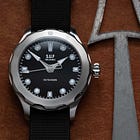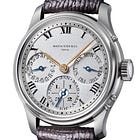Issue 169: The Watch That Changed My Mind About Christopher Ward
It's not the Loco, and it's not the Bel Canto either.
Hello and welcome back to The Fourth Wheel, the weekly watch newsletter that has got all the details of Taylor Swift’s engagement Cartier for you! Only joking. I had to laugh when I saw Hodinkee’s Instagram post on the “news”, saying “Tim Jeffreys has more details at the link” No he doesn’t! There’s no ‘more’ to have. A very famous woman wore a Cartier Santos Demoiselle to get engaged in. That’s all there is to it. Nothing against Hodinkee in particular and definitely not against Tim - just doing his job - but I can’t stand the traffic-farming, shoji-thin pretexts for content that fill up what we used to call ‘watch culture’. I’m not immune to the cultural significance of mega-celebrities and I’m sure the watch in question will skyrocket in price, Cartier will be cock-a-hoop and so on, but there is no story here. Dog bites man. Carry on. What I’ve really got for you today is half hands-on review, half reappraisal of a brand that some say I talk about too much. I agree there are more horologically interesting stories out there, but as a case study of modern success, I find CW fascinating.
Also after the paywall: news on Fabergé, a JFK timepiece and the oldest watch ever made
Next week is Issue 170 and you know what that means: it’s AMA time. Ask Me Anything - for newcomers, I do this every ten issues. I already have a couple of questions but I need more! Please don’t hold back, I want you to bombard me with enquiries of a horological nature. Send DMs, post comments on this newsletter, contact me on Instagram, it’s all good, and the more specific or esoteric the question the better.
The Fourth Wheel is a reader-supported publication with no advertising, sponsorship or commercial partnerships to influence its content. It is made possible by the generous support of its readers: if you think watch journalism could do with a voice that exists outside of the usual media dynamic, please consider taking out a paid subscription. You can start with a free trial!
Here’s a little taste of what you might have missed recently:
Moving up in the world
It’s a constructive experience, having your mind changed. They say as we get older we become more resistant to opposing ideas, more set in our ways - and I have caught myself behaving this way on occasion. But I’ve also always said that the more you know, the more you realise there is still to learn, and I think that’s definitely true in watches.
I’ve written about Christopher Ward on and off for years. I covered their early watches for QP in the 2010s, and I even had a C9 Harrison Jumping Hours at one point, with a dial texture that would go down quite well in today’s market, and a 43mm x 13mm case that really wouldn’t1. Back then their brand was heavily invested in tapping into the Great British Watchmaking Tradition - i.e. using names like Harrison to borrow some credibility - and the majority of its tool watches were unimaginatively derivative of Rolex and Omega icons. I covered its introduction of the SH21 calibre and the merger with Synergies Horlogeres SA in 2014 that enabled it to describe itself legitimately as an ‘in-house’ watchmaker - provocatively, the same year that Bremont was so badly burned for falsely claiming its La Joux Perret calibre was an in-house movement. I remember sniffing at its logo change the following year, thinking that the abstract spin on the Swiss flag motif was bland and sterile, more evocative of a utilities company or a marketing agency than a luxury watchmaker. This was a time when even if your forum loyalists would be up in arms, at least you could push through a re-brand without getting flamed on Instagram and YouTube.
It is so interesting to look at Bremont and Christopher Ward over the last 20 years. That’s not the focus of this post, although it would be a good one. Each brand took an almost opposite path to end up in a place where both are trying to offer a competitively priced alternative to mainstream Swiss watchmaking. Bremont tried to emulate its Swiss rivals and - although the current strategic shift is still ongoing - has ended up undercutting them on price with the Terra Nova and Altitude, while Christopher Ward started out undercutting the Swiss and has been able to elevate its brand to the point where it can sell out a three or four grand watch with ease. At every turn, they took opposing positions: direct-to-consumer vs traditional retail; luxury marketing and ambassadors vs plucky underdog ads; doing as much as possible in the UK vs finding a Swiss partner… it goes on and on. Bremont were always smooth and charming, forging great relationships with the British press, while Christopher Ward, although good for a spicy quote, were less inclined to play the schmoozing game, and took a lot longer to get us champagne-quaffing writers on side. (And the two brands squabbled over British Armed Forces partnerships, because there are some things that even the most patriotically-apathetic businessman in this country finds hard to pass up, and the chance to cash in on military connections is one of them).
On most, if not all counts, you would now have to say Christopher Ward chose the better option. Whether by luck or judgement, its decisions better equipped it for today’s watch landscape. The logo still isn’t my favourite but on today’s product line-up, it works well. (It wasn’t seen this way a decade ago, but today leaving your brand name off the dial puts you in cool company - think Ming, H. Moser - and displays confidence.) The brand has been able to slough off most of the heavy blanket of Britishness that seemed necessary - to both brands - to wear in the 2000s and 2010s and is more able to stand as a contemporary, ambitious watch brand that just happens to be headquartered in the UK.
You live and die by the product, though, and until recently I still thought Christopher Ward was hampered by its ‘value proposition’ ethos. Things had got better, for sure, and it had proved capable of nimbly latching onto trends as they bubbled up, but I was still looking for evidence of real originality. I’ve written it several times on TFW before, but the brand’s greatest strength was also what held it back: presenting yourself as a cut-price alternative to luxury titans is always going to stop you earning a seat at the same table.
Then the Bel Canto came along. I didn’t see it coming. Who did? It was super smart - both mechanically, repurposing the JJ01 module into a chiming complication - and strategically, arriving at a time when the collector world was hungry for alternative styles at attainable prices. It deserves its awards. But it didn’t bowl me over like it did others; I found the launch event snarled in the trappings of ‘old CW’ - essentially, the brand was yet to realise how cool this watch was going to make it, and had booked out an esoteric venue in West London (which had connections to classical music, granted) and put on an evening that was neither as luxurious as you’d expect from a mainstream brand launch nor as free-wheeling, fun and punky as the Time+Tide model of today. (We’ve come a long way in a short time on that front). That wasn’t really my main objection to the Bel Canto, though. I thought it borrowed amply from the likes of MB&F, even old Maurice Lacroix and Armin Strom, and although I respected what it was doing, I didn’t actually want the complication - it didn’t move me personally and looked like a solution in need of a problem.
With hindsight, I’d have been tempted to launch the Loco before the Bel Canto - but that would have been a mistake. The Bel Canto had shock value; inching up on it incrementally would not have made the same impact. With the C12 Loco, much of my earlier objections start to fade away. The design language is starting to hang together, and the marketing is hitting the right notes too: the short documentary film they put out brought in a welcome tone of self-deprecating modesty.
But as teased above, we’re not here to talk about the Loco. It probably is going to be a marvellously important watch for the brand, ushering in a new generation of movements that I suspect will continue to win over purist watch collectors who were turned off by the Sellita-based tool watches. But it remains a fairly niche proposition; open balance wheel watches with bright orange dials are brilliant for Instagram and catnip for seasoned buyers who’ve seen it all, but they’re not the bread and butter of a mainstream watchmaker. I recently sat down with Jorg Bader junior, who runs product development for Christopher Ward over in Biel, and he agreed: the brand is in a position where it serves two audiences, and I am here to sing the praises of a watch for the mainstream, not for collectors.
How’s that for an intro? Now, finally, we’re going to start talking about the watch.
Keep reading with a 7-day free trial
Subscribe to The Fourth Wheel to keep reading this post and get 7 days of free access to the full post archives.





